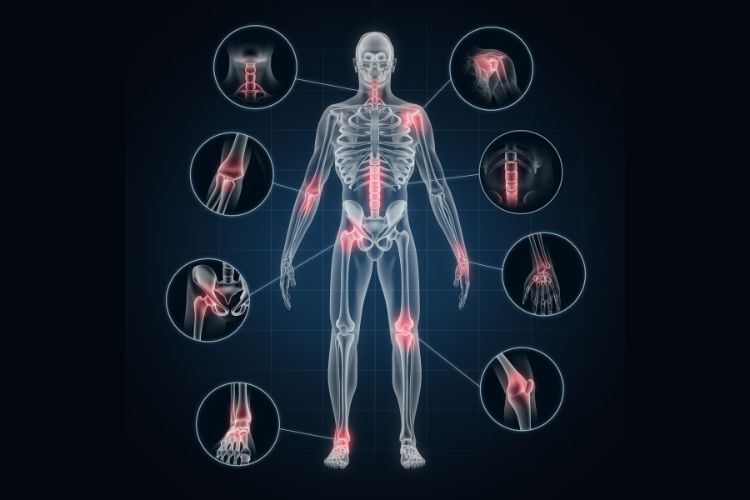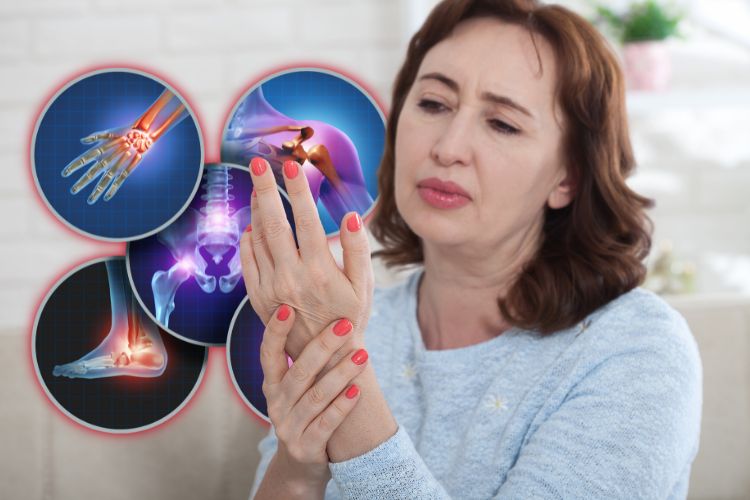Menopause is a period of life for women when the menstrual cycle ends, and a new stage in life begins. This stage is a stage of hormonal fluctuations that can cause a variety of symptoms.
There is a clear link between menopause and joint pain as a key symptom of menopause. Menopause occurs between the ages of 45 and 55 and begins after a woman has gone twelve months without a menstrual cycle.
The average length of menopause can be approximately seven years, but menopause can go even longer and up to fifteen years. There are many contributing factors to the length of menopause, including lifestyle factors such as smoking, and overall health. During menopause, the key hormone that is fluctuating is estrogen. It is these fluctuations that cause the link between menopause and joint pain.
Learn more here about why you might have aching joints with menopause.
Understanding Menopause and Joint Pain
Menopause affects every woman differently, although there are key symptoms that connect joint pain with this change in life. Other symptoms that you will have with menopause include headaches and hot flashes as the most common changes. Still, other symptoms include a change in body shape and joint pain. All of the sudden symptoms that are experienced during menopause are related to the changes of estrogen in the body.
Key markers of body changes that occur with women in menopause include larger waists as your body loses muscle and accumulates more fat. You may find your skin becomes thinner, and other symptoms like memory issues occur. With the joint pain that comes with menopause, women report feeling achy in all areas of their body.
Joint pain can occur in major joints like elbows, hips, and knees. It may be seen everywhere though, from the fingers to the ankles and every joint in between. That is because estrogen receptors are found everywhere in the body and in the joint areas.
When estrogen levels decline, additional inflammation and wear and tear can occur at the joints which causes the pain of aching joints during menopause. Inflammation occurs because the cartilage in and between the bones becomes weaker and begins to deteriorate.
The role of estrogen in bones is to protect the bones and to reduce the amount of inflammation. When estrogen declines in levels, you may see swelling and pain in the joint area. A reduction in estrogen levels will also result in an increase in the risk of osteoporosis, where bone density drops and arthritic pain is experienced in the bones of menopausal women.
Osteoporosis makes the bones weak and brittle and could result in more symptoms during menopause. It is estimated that approximately 40 percent of women going through menopause are experiencing the problems of menopause and joint pain. This could last the entire duration of menopause, or longer if it is not managed or treated.
Symptoms of Menopausal Joint Pain
The symptoms of menopausal joint pain will be different for everybody. The most commonly reported symptom is the symptom of aches and pains. Some of the pain can appear as a simple ache that goes away and comes back on occasion. Other kinds of joint pain during menopause include twinges and sharp shooting pains in the area of the joints.
For some, the pain of joint pain and menopause is debilitating. They can not get up and walk normally in the mornings. The joints may feel stiff and too brittle to move. You may also see some inflammation here.
Pain will be felt at the joints and with the bones, but will also come from the tendons and muscles. It is worse in the morning after sleeping and lying down all night, and it will loosen up and feel better as the person walks around and performs daily activities more.
One woman reported that she could not get out of bed in the morning and some days and this came with emotional mood swings that made her consider starting early retirement from a job that she loved.
Another woman said that headaches and dry eyes were common during menopause, but the joint pain was the most memorable symptom. She also gained 40 pounds during menopause, and this put a strain on her joint pain. She is another woman who described constant mood swings and the joint pain in her fingers was reported as unbearable. It made work difficult for her and she ultimately retired early.
Back pain and neck pain are also commonly associated with the joint pain that comes during the period of menopause. The pain can stay localized to the joints. It can also travel up and down the back, arms, and legs.

Causes and Triggers
The causes of menopausal joint pain is a result of the decreased estrogen levels in the body. However, underlying conditions such as pre-existing arthritis, rheumatoid arthritis, or fibromyalgia can also contribute to significant joint pain during menopause. All of these conditions are extremely painful, to begin with, and can be worsened with menopause.
Rheumatoid arthritis is not the same thing as osteoarthritis, a very common issue that occurs during menopause. Rheumatoid arthritis is connected to inflammation of connective tissue, but it is caused by an autoimmune disease that causes the body to attack itself. This is a serious condition with tremendous pain.
Fibromyalgia is another condition that causes joint pain during menopause and starts as joint pain without menopause. This is a pain that is caused by issues at the musculoskeletal levels. This pain will be felt around the entire body and can cause many symptoms including fatigue and brain fog. Some of these symptoms will feel like menopause symptoms and may overlap.
When estrogen levels begin to decrease in the body, these conditions will worsen and the pain will be more unbearable. Estrogen receptors responsible for reducing inflammation around the joints from the fingers to the toes will weaken, and so will cartilage, bone, and connecting tissue. Menopause hip pain and aching joints in menopause will worsen when someone is dealing with these pre-existing conditions.
Diagnosis and Seeking Medical Advice
The diagnosis of joint pain during menopause is simple but can be completed with diagnostic tests for other ailments in the body. If you are experiencing joint pain during menopause that makes life debilitating, it is time to see a doctor about that. Whenever a symptom interferes with your quality of life, it is important to talk to a doctor about it.
Additionally, if the joints that are in pain are swollen suddenly or appear red and hot to the touch, you should see a doctor. Your doctor can perform a full workup on your hormone levels including blood and urine testing to detect the amount of estrogen and other hormones in your blood. You may also need some X-rays to determine what is the extent of the damage of the joint pain that is sending you to the doctors.
Your doctor will want to know how severe your symptoms are, and when they began. A family history will be taken as well, and your doctor will review your current medications. Lifestyle issues such as weight, diet, and smoking will also be considered.
If necessary, your doctor may also take a sample of fluid from the joint to determine the extent of the inflammation. Your doctor may also make many recommendations on how to manage menopause and joint pain.

Managing Menopausal Joint Pain
There are many different ways to manage menopausal joint pain. Prescription medication can help, but so can many over-the-counter medications. You will want to try non-steroidal anti-inflammatory (NSAIDs) such as ibuprofen or naproxen to manage the pain. This will help you to reduce the joint pain that comes with swelling and pain that makes it difficult to walk.
Staying active is also important, as it will help to keep your joints and bones stable and strong. You want to ensure that you are enjoying a lightweight and low-impact exercise that will help you to stay energetic enough to keep the joints moving. Many women report that the pain decreases with activity during the day when they have joint pain and menopause.
Supplements such as Vitamin D and Glucosamine can also help. Vitamin D is important for bone health as it aids in the absorption of calcium which makes bones stronger. Glucosamine and chondroitin sulfate help with inflammation of the joints in all species, including cats and dogs. That is because it helps to strengthen cartilage and reduce the inflammation that happens when arthritis occurs, a common condition across multiple species.
Alternative Therapies
Alternative therapies for joint pain and menopause include acupuncture and yoga. These are low-impact and low-intensity pain relievers that can keep your blood flowing, and your endorphin levels flowing too. Endorphin is a hormone that is a natural pain reliever, and with increased flow, you will experience increased levels of pain relief.
Many studies have shown that acupuncture is very helpful when it comes to relieving pain during menopause. It can help with joint pain, but it also helps to reduce hot flashes.
You may also experience better sleep when you get acupuncture during menopause. This exercise targets the connective tissue to relieve pain with increased endorphin levels and reduced inflammation overall.
Yoga can accomplish the same effect because the blood flow is low impact and low in intensity. Yoga will also help with breathing and can help to improve your endorphin levels as well as give you a natural lift that reduces overall pain.
Preventive Measures
A healthy lifestyle is the most important thing to do when you are managing joint pain. You want to watch your diet, stop smoking, and stay active. These are the three most important things to do when you are trying to reduce joint pain.
A diet rich in anti-inflammatories such as kale, spinach, and other leafy greens can help. Start a schedule where you are exercising regularly and you will begin to experience the natural pain relief that comes with exercise. If you are a smoker, now is a good time to quit as it will reduce your blood flow and your ability to fight off the inflammation that causes menopausal joint pain.
Relieve Menopause and Joint Pain Symptoms Today
When you have joint pain during menopause, it will feel like the aching joints that come with menopause will never stop hurting. But they can feel relief, with a little bit of lifestyle changes and pain management. Preventive strategies such as yoga, acupuncture, and a healthy diet coupled with regular activity will also help. Talk to your doctor if the pain becomes too much to live with.
